Story and Photos By Clement Salvadori
I was a little concerned about riding through Iowa in June of 2011. Nothing to do with bandits, earthquakes or extra-terrestrial beings, just two big rivers. That spring, middle America was in full flood, with huge amounts of snow melting and heavy rains, and I was going to cross the two biggest rivers in this country: the Mississippi and the Missouri. (And I was hoping that the route I had chosen would not be washed out.)
The main attraction for me in Iowa stretched from river to river: the old Lincoln Highway, now known as U.S. 30. That was the original ocean-to-ocean road, conceived in 1913, constantly revised, but still pretty much a two-lane road in today’s Iowa. By the way, the Iowa nickname of Hawkeye dates back to the 1830s when the land was still a territory, not yet a state, and honors a Sauk Indian, Chief Black Hawk.
Also, I wanted to visit the National Motorcycle Museum in Anamosa, Iowa, and this was my opportunity. We have the better part of a dozen major motorcycle museums in this country, as well as a couple of dozen less formal ones, but I had never been to that one. Not that I knew where Anamosa was. Having just escaped the confines of Chicago, I pulled over at a rest stop on Illinois’ Ronald Reagan Memorial Tollway (heck of a way to be remembered, constantly asking for money) to have a look at the map. I saw that Anamosa was on Route 64, a state route number shared by Illinois and Iowa, and the tollway was equidistant from 30 and 64—I went north and picked up 64.
This took me to the sleepy river-town of Savanna, where I saw the first advertising for the museum, as well as for a small Harley museum located in a restaurant/bar called the Iron Horse Social Club. Being still morning, the club was not open. Savanna must have been a rip-snorting sort of place where the paddlewheelers would pull in 150 years ago. Then the railroad arrived in 1875, making this a real transportation hub. And a ferryboat would take you over to Iowa.
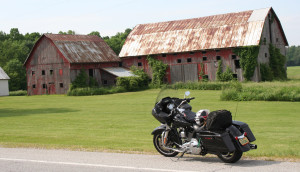
That ferry service pretty much came to an end in the 1930s when FDR was busy creating jobs and the government provided money to build a bridge over the Mighty Miss. It’s still a good bridge, well kept up. On a normal day, the center span stands 65 feet above the water, but on my day of crossing I figured it was a good deal less than that because the river was running high.
On the other side of the river is Sabula, Iowa, which is built on an island. The bridge leads on, a causeway leads off. The little island has three parallel streets and a population of only a few hundred, but apparently the land was high enough that nobody seemed worried about flooding. A train came along and crossed on the 100-year-old railroad bridge; the bridge has a section that lifts, allowing riverboats to get underneath.
I did manage to get lost on the island, but after asking directions and crossing the causeway I was back on the mainland. Iowa is justly known for its produce, with corn and soy high on the list, and edible animals, with some five million cattle and 20 million hogs. Over 90 percent of the land is given over to crops and grazing, and that provides a beautiful view. The terrain is not flat, but rolling, with lots of low hills and rivers; fertile is an understatement. Tractors plowing, cattle deep in green grass, blue skies and a few white puffy clouds—all is well with the world. Arriving at the town of Maquoketa, a sign told me that I was now on the Grant Wood Scenic Byway.
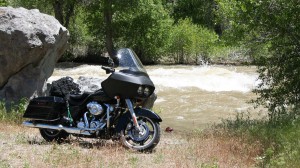
Anamosa, my destination, is also the birth and burial place of Grant Wood, one of America’s great artists. He is best known for his “American Gothic” picture of a very dour farmer with a pitchfork standing by his wife. In nearby Stone City, he set up an artists’ colony in the 1930s and painted a memorable landscape of the place with the Wapsipinicon River flowing down the middle. Much has changed in three-quarters of a century, but the old St. Joseph’s church of the painting is still there.
I was wondering how to find the motorcycle museum, but as I came into an intersection with Route 64 and U.S. 151, a big sign told me I had to look no further. The place is housed in a former Walmart store, a perfect museum venue, with acres of flat floor. Although it was a weekday, a dozen bikes and a few cars were parked outside, and inside was a bike-lover’s dream. There were upwards of 300 beautiful motorcycles of all makes and age spread out through the thousands of square feet, along with hundreds of moto-memorabilia items, from movie posters to racing leathers. The collection is eclectic, with lots of Indians, including one belonging to Steve McQueen, half a dozen Vincents, a slew of Kawasaki triples—way too many marques to try to list here. They were well displayed, many of them on stand-alone platforms allowing the visitor to see all sides.
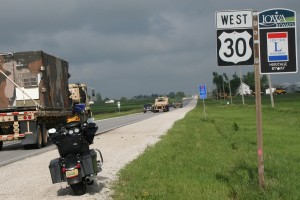
All this is due to John Parham, CEO of the big aftermarket company J&P Cycles, who rescued the museum when it was financially foundering and turned it into a self-sustaining non-profit organization. Good work. Parham hired Mark Mederski, who had been working at the AMA’s museum in Ohio, to run the show, and Mederski does know his stuff. Also, there is a very cool shop attached, with all sorts of things to sell, from postcards to posters, T-shirts to tin signs. Can’t afford a 1911 Harley? Get a postcard of one for 50 cents.
After the stop, it was time to get south to U.S. 30, which took me southeast to Cedar Rapids. Pulling out my reproduced “1916 Road Guide to the Lincoln Highway,” I read that Cedar Rapids was a biggish city even back then, with 40,000 people, even bigger today, with 120,000. The guidebook says: “Heavy rains can make this portion of the Highway difficult to travel.” Also, “Local speed limit 15-20 miles per hour, enforced.” No problem today as U.S. 30 is a 65 mph freeway skirting the southern edge of town, before reverting to a two-laner. As I noted before, most of U.S. 30 in Iowa is still two lanes—the kind of road any sensible motorcyclist likes to travel on.
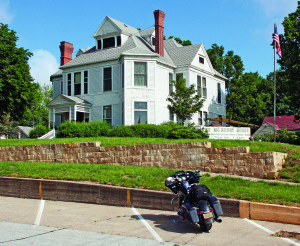
Moving along through the countryside I aimed for a night in Marshalltown, where the guidebook said that back in 1916 the local speed limit of 15 mph was not enforced. While having supper at a diner I struck up a conversation with some regulars and asked about the up-coming political hoopla in nearby Ames, when all the Republican candidates would be showing up for some sort of straw-vote ballot. “Don’t affect us none,” was the response, “but those folks in Ames sure appreciate all the money that show brings in.” There are definitely unseen benefits to the multi-layered financing of political campaigns.
One of the locals, a Vietnam vet, told me the last American casualty in Vietnam was a Marshalltown native, Lance Corporal Darwin Judge, a Marine guard at the U.S. Embassy during the fall of Saigon in 1975. Iowa has always served its country well in time of war, at great expense. A city park now honors his name. Just to add to that sad reminder, the vet told me that the first American death in World War II was also an Iowa native, U.S. Army Captain Robert Losey, from a little town called Andrew. He was a military attaché helping to evacuate U.S. embassy personnel from Norway after the German attack on that country in April of 1940. This is the price we pay for freedom.
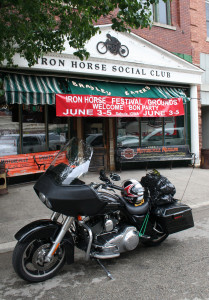
Up early and away, and in less than an hour I was crossing over the Skunk River in Ames, and then on to the open farmland, white barns and houses scattered alongside the road. U.S. 30 gently rises and falls, and I seemed to cross a new river every 20 miles or so. Off to my right was Beaver, whose moment of distinction came in 1914, a year after the Lincoln Highway was officially designated, by being the first town to be bypassed by a major highway. Local authorities felt that straightening the road and avoiding a couple of railroad crossings (now Union Pacific RR) would be a good idea, so they moved the road north of town and built the Marsh Bridge over Beaver Creek in 1915. The bridge, called a rainbow because of its curved design, is still there, though extensively renovated in 1999.
Present-day U.S. 30 does not pretend to follow the original route of the Lincoln Highway, which originally was not much more than a one-lane dirt track. Today it runs south of Beaver, the little town still being home to some 20 families. Signs along U.S. 30 point to many of the original portions of the highway, mostly still unpaved but easily negotiable with a street bike.
Coming to the town of Glidden, a large memorial stands on the north side of the road to commemorate the life and death of Private Merle D. Haye, one of the first two American soldiers to be killed in World War I, serving with the First Infantry Division, or Big Red One. Since two soldiers were killed in the same attack, nobody is quite sure who had the dubious honor of being first.
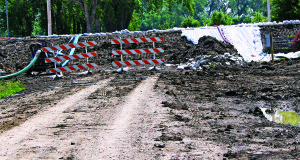
Going by Arcadia, the road descends to cross and parallel the East Boyer River, and a dozen miles later Harley and I were entering Denison and the confluence with the main Boyer River, which we would follow for the next 50 miles to Missouri Valley. But first a look at Denison. On a hill in the middle of town is the W. A. McHenry House, built by a successful businessman in 1885 and now a museum with fine displays of late 19th century furnishings. But the town is more famous as the birthplace of Academy Award-winner Donna Reed, who every classic-movie buff knows was famous for her roles in From Here To Eternity, It’s A Wonderful Life, and other movies and TV shows. That was all happenstance as Reed never intended to be an actress, but after high school went to Los Angeles to live with an aunt and go to college. And the rest is in her biography. After her death her husband set up a performing arts center in the town, which is acclaimed to this day.
Now we were heading southwest into the Loess Hills, a beautiful 200-mile chain of hills on the east side of the Missouri River. I stopped at a state-run welcome center a few miles before the town of Missouri Valley, and the lady there almost convinced me that I should not miss the Loess Hills Scenic Byway. Her descriptions were very appealing, but I had places to be. As I went through Missouri Valley I saw a dozen sportbike riders having a soda at an outdoor café—I bet I knew where they were going.

Missouri Valley has changed a bit since 1916. The population dropping from 4,000 to 3,000 left few stores catering to the locals’ needs. Half a dozen gas stations and a couple of motels cater to the travelers, but that is about the extent of business. I-29 now runs north-south along the west side, with the big city of Council Bluffs less than 20 miles to the south.
At Missouri Valley, I deviated from the original 1916 Lincoln Highway, as I wanted to avoid crowded places like Council Bluffs and Omaha, Nebraska, and instead turned west toward California Junction. Originally U.S. 30, as the Lincoln Highway was designated in 1925, the road went down to Council Bluffs where a bridge crossed the Missouri. However, when another bridge was built between California Junction and Blair, Nebraska, in 1929, the mapmakers in Washington changed the course of U.S. 30. The old bridge, called the Abraham Lincoln Memorial Bridge, a suitable name for a bridge on the Lincoln Highway, was a steel truss with a grate surface, but that was torn down and replaced in 1991 with steel-stringer construction.
The whole Missouri River valley is prone to flooding, and the last 10 miles to the river are dead straight, dead flat. The new bridge, with an asphalt surface preferred by motorcyclists, rises well above the river, although the road leading to it can get covered with water—as it did several times in 2011. The railroad parallels the car road, and the original train bridge, built in 1883, is still in use.
The river was up, way up, much more than the Mississippi, and on the Nebraska side I saw crews working hard to build temporary embankments to protect a fuel depot on the river’s edge. I was moving on, heading for higher, drier land. But I do have to get back to do the Loess Hills byway some day.
(This Crossing Iowa article was published in the September 2012 issue of Rider magazine.)

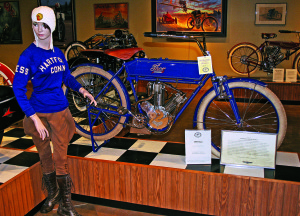
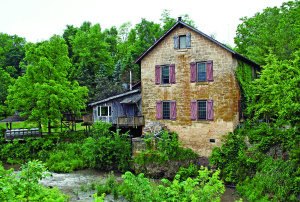
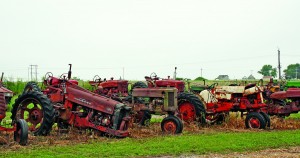
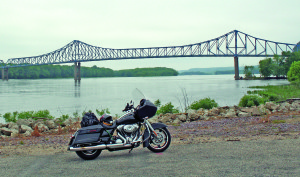







Clem, Clem, Clem, surely you didn’t just follow Highway 30 across Iowa. That’s like taking I-40 from Chicago to LA instead of Route 66!
You spent the night in Marshalltown and didn’t take the real Lincoln Highway to Ames? When it’s named Lincoln Way in both cities? And has wonderful sections of curves and PAVEMENT as narrow as seventy years ago? You missed the section that goes through the back side of the Mesquakie settlement? Come on!
And by the way, the Hawkeye state is named after the character in James Fenimore Cooper’s novels (Last of the Mohicans), which were set in the territory that Iowa was carved out of, not Chief Black Hawk. There is a county named after the great Chief, though.
Try to research your route and your history a little better next time.
Hi Clement,
I came across your article, road tales Thoughts on travel in the October’s Rider.
I must share this with you. I as well had a Triumph Bonneville episode in
France. It was 1966, just before my discharge serving four wonderful years
at Chateauroux Air Force Base. I got a military aircraft hop to London, purchased a new 1966 Bonneville and rode it back to my base in France.
I was discharged in France serving my four year term.
I then set out to conquer as many roads in Europe and North Africa while my money would hold out. There was a time I washed dishes at a cafe in
Gibraltar to earn gas money. I worked on an Air Force’s base post office in Spain during Christmas mail rush for room and board and a couple of shekels.
The most memorial story took place in Cassia Blanca, Morocco. There I was, leaving the hostel, one dirham for a night’s stay. (20 cents) headed to Marrakesh. I hopped on my Bonne, turned on the ignition and puff,
smoke came bellowing from under the seat. Yes, Lucas the Knight of darkness stranded me for three weeks. I had to order a rectifier from Pride and Clark the cycle shop where I purchased my Triumph. The three weeks waiting time proved to be quite a lucky experience. Coincidentally,
the next day I met a charming young lady that checked into the hostel. We discovered she graduated a year later from the same High School in Bayside, Queens N.Y . I never made it to Marrakesh or my destination, Dakar. I made my way back to Europe covering most of the countries.
I had many many exciting experiences and tales of woe. What really gave me tons of notoriety was every country and every village I stopped at I was always circled by men young and old admiring my Triumph Bonnevile and asking me how fast it can go. Other then a gendarme on a 500 BMW only England had larger cc motorcycles.. I spent six months touring until I shipped my Triumph from La Harve port back to USA.
I still ride, but in comfort on my Ultra Classic.
Denis